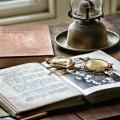THE SADDLERY F George and Son at 8 Bridge Street has largely slipped from folk memory but the shop’s history as a saddlery was a very lengthy one.
This 1907 picture shows master saddler Frederick George standing in the centre, with eldest son Thomas standing to the right and a younger son Albert to the left.
Both sons were saddlers and at this period were working with their father, to whom they would have been apprenticed.
Thomas took over the shop in the early 1930s after the death of his father and continued until 1952 when he reached the age of 73.
By that time, he had been a saddler for 63 of those years and the shop with its blackened oak beams and walls, draped in leather collars, harness, saddles, straps and belts would have looked much the same as it had a century before.
Today, next to the White Hart hotel, there are two adjacent shops built into the ground floor of one unassuming 18th century house.
However, the former saddler’s shop is much older than the charity shop next door, the latter being an early 20th century conversion.
The two shops evolved from the former ‘house, barn and yard’ identified in the returns for the Tithe Survey of 1848, although at that time it was likely the barn in the yard to the rear was the saddler’s shop.
When shops were run by families, a similar business was maintained over many generations and even when families died out or moved away, they were replaced by another family who continued with the same trade from the same premises.
And indeed, there was a succession of identifiable saddlers that ended with Thomas George in 1952.
Mr George’s father, the original Frederick George, was the proprietor in 1901 but an employee there for at least 20 years before that.
Two Bridge Street saddlers of short tenure are listed in the 1890s but before that the shop was occupied by Joseph Grace Hewett, for something like 40 years.
Before his time, the census of 1841 places saddler Thomas Purchase at Bridge Street as does Pigot’s directory of 1830.
Going back further is speculative but a late 18th century directory lists only two saddlers in Andover – John Eaton and Charles Jacob but with no address shown.
As the latter can be placed in the High Street later on, it is reasonable to suppose that John Eaton was the Bridge Street occupant and an apprenticeship indenture records that John Eaton, master saddler, had apprenticed one John Harding at Andover in 1794.
Some final snippets of interest come from June Harris who lived two doors away from Thomas George and his family in Old Winton Road: Mr George served in the Yeomanry during World War I, acting as a farrier to the huge number of horses needed for service in France, a job to which he was admirably suited.
In the 1930s he served on Andover Borough Council.
Mrs George did all the accounts for the saddlery and belonged to several local associations, including the food committee during the Second World War.
She was proud of her nephew John Dunn, a grammar schoolboy who passed the requisite exams to go to London University in 1947, an almost unique achievement locally in those days.






Comments: Our rules
We want our comments to be a lively and valuable part of our community - a place where readers can debate and engage with the most important local issues. The ability to comment on our stories is a privilege, not a right, however, and that privilege may be withdrawn if it is abused or misused.
Please report any comments that break our rules.
Read the rules hereLast Updated:
Report this comment Cancel